#tadoku level 2
Text
Pan dorobō
New item:

A shadow quickly appears from the bakery in the town. A loaf of bread runs away carrying a loaf of bread. I am the bread thief also known as the great thief in search of good bread. Who is this bread thief wrapped up in bread? The mischievous and lovable Bread Thief is causing trouble today!
Shelf: 726.6 SHI 1 (@ tadoku section)
Pan dorobō.
by Shibata Keiko.
Tōkyō : Kadokawa, 2020.
ISBN: 9784041090602 (hardcover)
[32] unnumbered pages : colour illustrations ; 25 cm.
(Pan dorobō no ehon ; 1).
Text in Japanese, hiragana and katakana only.

This book is suitable for tadoku, extensive reading for learners of Japanese-language. Please find details about tadoku and our reading night event on ourtadoku web page.
#japanese language#readers#tadoku level 2#picture books for children#juvenile fiction#bread#thieves#jlearner#jteacher
15 notes
·
View notes
Text
Japanese Reading Resources for Absolute Beginners
A question I encounter often is "How much Japanese should I study before I can begin reading in Japanese?"
From my experience as a learner and reader myself and from managing a Japanese book club for other learners I can honestly say that you can start way earlier than you probably think!
There are many resources that only require knowing hiragana. Those texts usually teach vocabulary through pictures and only use basic grammar.
Some are even simpler than that: The Japan Foundation's Hiragana Books are great for those, who are still remembering hiragana characters. Every short book introduces only 1-2 new characters, so it's a great reading exercise for those who've just started.

The free graded reader 「どうぞ、どうも」 by the NPO Tagengo Tadoku only uses the words 「どうぞ」 and 「どうも」 to write an entire story. Again, this makes for a great exercise in reading hiragana and understanding context. Another "level 0" recommendation by the same NPO would definitely be 「しろい?くろい?」. This book uses the full range of hiragana characters but the grammar is simple and all used vocabulary is illustrated.
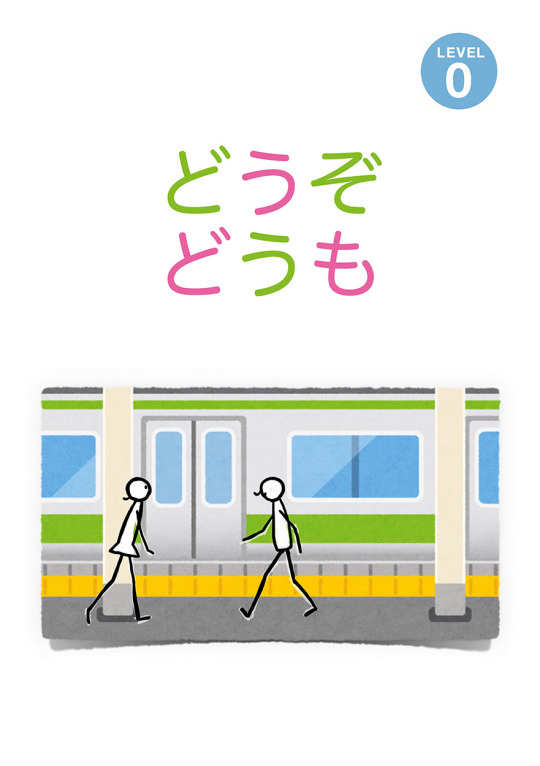
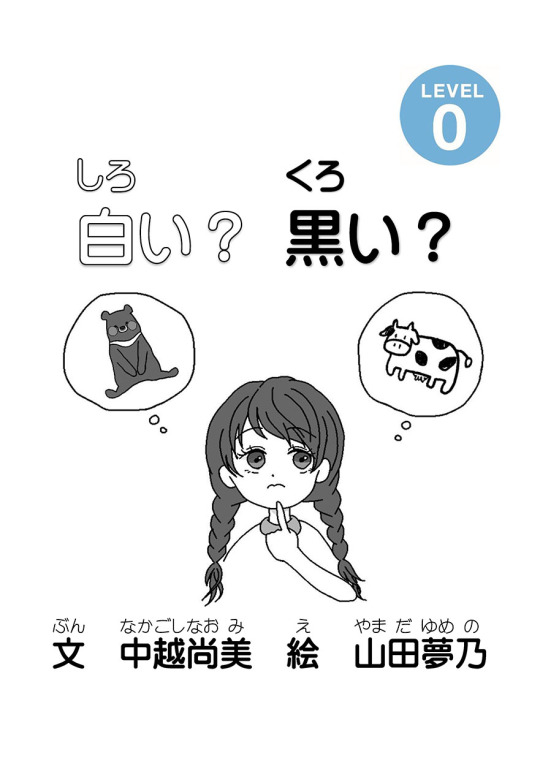
Another site with great resources for absolute beginners is Nihongo Tadoku Dōjō. If you have memorized both hiragana and katakana and know how the particles を and で work you will be able to read this text about stationary (ぶんぼうぐ) and understand everything by looking at the pictures!

The resources linked so far can all be accessed completely free on the linked websites. If you have the money to spare, please also have a look at the box 「スタート」 from the series reberubetsu nihongo tadoku raiburarī published by the NPO Tagengo Tadoku and ASK (affiliate link). This box includes 8 little books in very simple Japanese.
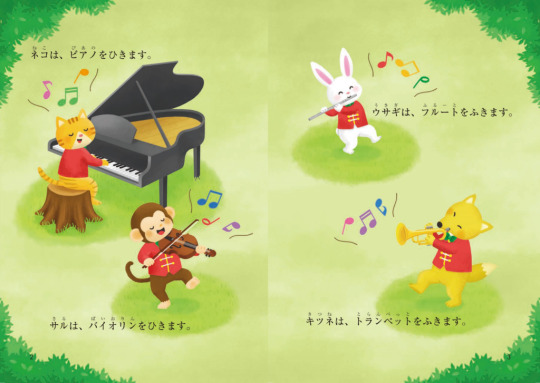
All these texts for absolute beginners will get you started reading in Japanese with very little knowledge of characters and vocabulary.
Reading in Japanese is a skill that requires practice. But once you get used to it, it can be such a valuable tool to reinforce new vocabulary and grammar. So please don't wait until you're "ready" before you start reading - start early at your own level!
#my book reviews#reading in japanese#study japanese#learning japanese#日本語#japanese books#やさしい日本語#free graded readers#free tadoku graded readers#nihongo tadoku dōjō#absolute beginner level#japanese langblr#japanese language#japanese reading comprehension#japanese free reading resources#japanese reading resources
913 notes
·
View notes
Text




3rd April 2024
Day 2 of 100 days of productivity.
I have my exams for Japanese coming up and I'm way too behind on the syllabus and have an especially weak vocabulary. So I've been trying to read up in Japanese from sources other than the college textbooks. I managed to get some Level 4 and 5 short stories off of Tadoku and so far have read 3 out of the 6 I had downloaded and thoroughly enjoyed it, especially the ones that revolve quite a lot around wordplay.
Today I've started with 幽霊床屋(ゆうれいとこや).
I tend to highlight the kanjis I'm already familiar with, which most people find dumb but but hear me out. It gives an odd sense of satisfaction as opposed to when I used to highlight the kanjis I needed to learn/retain. Now when I can easily recall the reading of the Kanji, I highlight it. That way I can also get an idea of just how many kanjis in a single page am I familiar with. it's like a progress tracker. I do this mostly with new reading materials and not my college textbooks since the vocab and kanji of college prescribed books are a compulsion to learn before the start of a new chapter anyway.
I think I'll post the 新しい単語(あたらしいたんご) in a separate post, once I'm done with the story.
#Spotify#studyblr#new studyblr#studyspo#language#langblr#japanese langblr#study community#study blog#study motivation#日本語の勉強#desi tumblr#studybuzz#study aesthetic#bookblr#reader#100 days of productivity
20 notes
·
View notes
Text
My Japanese Reading-Corner, feat. some free reading materials
I use OneNote for my studies & I created a dedicated section where I can keep track of all the things I am reading.
It was important to me to give this page a pleasant design - I want to feel cozy the moment I jump to my Reading Corner ; u ; )
Since I am reading a lot of Graded Readers on Tadoku I am dividing them into their Levels as well.
LV 1 and LV 2 are very easy for me and I could jump to Lv 3 right away, however all these graded readers still teach me plenty of new words, so I don't want to miss out on any of them.
Thus, I am making my way through Lv 1 & Lv 2 first - the more I read, the better! ( . u . )
Aside from Tadoku, I also read on EbookJapan - they have a very big selection of free Light Novels & Manga across all Genre.
Access is time-restricted though, as after a while, the selection changes and new titles replace the current ones.
Thus, if I find something interesting I have to keep in mind to finish reading it before it vanishes.
However, there is of course still the option to buy the ebook version for usually very cheap prices ( . u . )
If you are looking for websites where you can practice reading in japanese I definitely recommend these two sites.
Tadoku's graded readers should offer something interesting across many Levels - and so does EbookJapan~! ( . u . )

#japanese#study japanese#learn japanese#learning japanese#japaneseblr#studyblr#study motivation#studyspo#immersion#reading immersion#reading material#japanese reading material#study resources#japanese resources
124 notes
·
View notes
Text
7月24日の勉強日記
I've finished most of my studying for today, all I have left to do is one more round of WaniKani reviews this evening.
Today I Did:
Anki, reviewing Genki 1 vocab and starting Genki 2
WaniKani, finally unlocked all level 1 kanji
Listening practice watching a video from Comprehensible Japanese on YouTube
Still Need To Do:
Final WaniKani reviews
Reading practice using tadoku
Finally, I wanted to do some writing practice, please feel free to give corrections as long as you're kind!
今朝���午前十一時に起きました。朝ごはんを食べなかったてす。日本語を勉強しました。次に昼ごはんを食べました。昼ごはんはサンドイッチを食べました。サンドイッチはおいしかったです。
今はなつ休みです。だから、ひまがたくさんあります。ひまで友だちとゲームをするのが好きです。いろいろなゲームが好きです。
2 notes
·
View notes
Text

2022年10月31日
Fall is in the air and it's a cozy time to study Japanese. It's also a time of the year that marks the busy season for students and employees alike. This fall I have been focusing on reading, trying to read anything and everything, and focusing on retaining things like vocabulary and kanji from these readings.
秋されの折、皆様にはますますご健勝のことと存じます。家で日本語の勉強することがぴったり季節ですよ。そして、学生も社会人もますます忙しくなる時期ですね。今年の秋の目的は日本語でいつでも何でもことに集中しています。読んだ単語や漢字も覚えられます様に努力をしています。
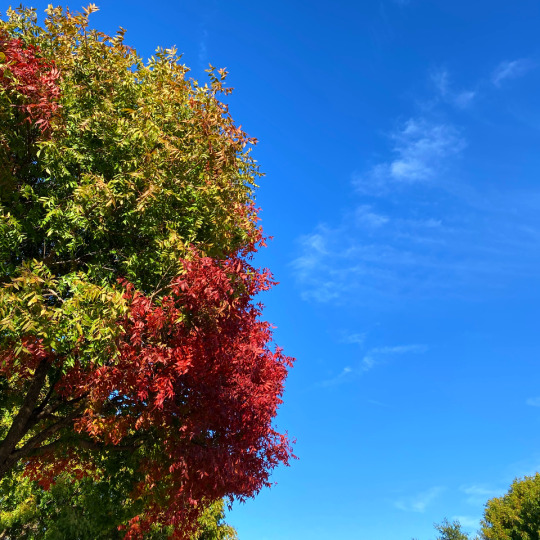
What I've Been Reading This Month
夜カフェ (Yoru Cafe) - A chapter book aimed at children, with the characters being around middle school age. Cute and heartwarming, but with a very slow pace, this is the first book in a series.
月刊少女野崎くん (Monthly Girls' Nozaki-kun) - A manga about a male high school student who illustrates girls' manga, his female classmate and fan, and all the other characters around him that he inserts into his work.
おじさまと猫 (A Man and His Cat) - A manga about an older man and the cat he adopts. Funny but with plenty of tear-jerking moments, this is a fast and adorable read.
NHK News Web Easy - Quick, easy-to-read articles designed for language learners and school kids to read. You can turn on/off ふりがな and the articles include up-to-date news information.
NHKニュース - The regular NHK news site, for when I have some more time, to read more in-depth articles for a Japanese audience.
絵本 (picture books) - Reading picture books with my son is a great way to practice 1) reading walls of hiragana, 2) reading aloud, 3) daily words with my son.
にほんごたどく (Tadoku Graded Readers) - A treasure trove of free graded readers for beginners and those who want to practice reading in Japanese. (Might I particularly recommend デカりんご).
Other Study Tools I Used This Month
renshuu.org - Kanji & vocabulary quizzes
Jisho.org - English/Japanese Dictionary (one of the most used dictionaries)
weblio - Japanese-Japanese Dictionary
言葉で遊ぼう (Kotoba de Asobo) - Japanese Wordle
Japanese podcasts
Things to Try Next Month
I spent October working on reading, and trying to focus on attaining new vocabulary and kanji knowledge at the same time. So in November, I'd like to focus on a different aspect of Japanese learning. I would like to get back into grammar, reviewing and learning new grammar points.
Handbook of Japanese Grammar - A grammar learning resource, separated by each grammar point.
日本語の森 (Nihongo no Mori) - Grammar videos separated by level, short and sweet for review or learning new grammar.
As the year comes to an end I will be looking back at how I started this monthly diary of my Japanese studies, and where I am now. I would like to review my goals and renew them. Have some of them changed? Definitely! Have some of them remained unfulfilled? Most certainly. But that is a natural part of the language learning process, and the changes in my goals reflect the changes in my priorities and the evolution of my knowledge of the language. So look forward to that in the next update!
Thanks as always for reading!
年末がどんどん近づいてて、今年の最初の目的と今までの進歩を分析したり、比べたりしてまとめて書こうと思っています。来年の目的も考えておいて、日本語の能力の成長について書き留めておこうと思っています。今までの目的が変わったり、満たされてなかったりしても、それは言語の勉強の一方だし、それからも成長ができて、自分の目指してる夢も叶えられますし。だから、来月も楽しみにしてね!
いつもありがとうございます!
#日本語#japanese#japanese langblr#japanese language#langblr#studyblr#日本語の日記#japanese diary#japanese goals#japanese goals october 2022#japanese goals 2022#tokidokitokyo#japanese studyspo#tdtphoto#my photo
56 notes
·
View notes
Text
me discovering japanese musicals and plays:
well i guess i really DO need to learn well now ToT
---
some april notes as the month is getting closer to the end:
i have read 2 full graded readers (butterfly lovers pleco reader, chinese short stories ebook). i’ve read also part of the 500 word Sinolingua book (and looked through the vocab index and know every word in it). And part of Journey to the Center of the Earth Mandarin Companion (I should finish it today as I know all the words in it ToT its one of those cases where its so simple its almost boring).
i watched through the about 2 hour japanese Dracula Musical - no subtitles, and the first time i’ve ever braved either japanese nonstop that long OR japanese audio with zero subtitles in any language to rely on. i feel really ;-; accomplished compared to what i’ve done before aha
i watched 20 minutes of a japanese Persona 2 Innocent Sin last night (japanese subs). i do actually think with lets plays combined with subs and my chinese hanzi recognition, i could pick up some new words if i just did it More Often. Anyway this is just notable since the Dracula Musical made me brave enough TO try this with a game i have no context for lol.
i watched 25 episodes of a show in chinese this month (Two Souls in One). Depending on when it ends i might have watched 30 by the end of the month, since its about to finish.
i’ve read a bit over 20 chinese chapters this month - i probably won’t get where i wanted with hanshe, but i’m doing a good amount and that’s what matters. i got distracted with graded readers (which i do think are helping me).
i studied about 350 common words in the nukemarine memrise course this deck, along with the grammar and kanji i already had done. i’m hoping i’ll get this number up a bit more before my japanese games come in ToT (my ideal would be at 1000 words but... i’m trying to be realistic and my motivation just is NOT there to cram that many right now probably). Still, 350 in a month is pretty good progress!
just in general both chinese and japanese are doing better than expected right now. chinese has been doing how i’d like it - the show i’m watching never requires me to lookup words to follow or enjoy the plot, just some replaying scenes to catch more details sometimes. reading wise: reading these graded readers is giving me a REAL sense of accomplishment - seeing what was once super hard for me take only 30 minutes to read, seeing a book full of unknown words now be full of words i completely know, seeing myself speed read over a book that i used to have to slowly glance through and re-read to grasp. i HAVE made progress in the year since i last tried to read these and it shows. i am super excited to see what reading the little prince will be like since i have memories of struggling through it before (and when i watched the youtube video reading recently it i realized i knew all the words in those videos). also - i am reading Guardian right now. I am reading my print novel of Guardian! that’s been a goal since i started! And as of now it IS something I can do right now, no dictionary (as long as i’ve read the english translation at some point prior). The reason i’m not doing it more right now is my reading speed for it is SO slow. So hopefully a bit more practice will speed it up. I’m seeing now with graded readers how much my reading of THEM has sped up, so there’s hope.
I also read a info page for the bilingual Dracula today and it mentioned a 26-29 hour reading time and that makes me feel a lot less bad about my reading speed? Last time I calculated how long it would take me to read hanshe at my current speed (roughly 15 minutes per chapter), 55 chapters left was going to take me 26 hours to read. Now... unfortunately the chinese novels i read tend to be 100-150 chapter long beasts. But - to see that a french/english book of about 800 pages would take me about as long makes me feel like i’m not reading so slow as it feels. i think i am reading chinese slower than english, but not dramatically slower. I need to actually MEASURE my reading speed sometime soon. But I’m pretty sure its like ‘slow speaking speed’ to ‘normal speaking speed.’ it unfortunately is not faster than speaking speed, but i do think for the most part its usually at least that fast.
update read 2 japanese graded readers (but they are Very Easy) - Tadoku Graded Readers: https://drive.google.com/drive/u/0/folders/1yr867g4mSoMJ0WKXVRdZf07tSyC7LMB1 . Level 0, Volume 1, on book 3 now.
update: just l r method chapters 1 and 2 of A Brief History of Human Kind. Will maybe do chapter 3 tomorrow. I have the files all emailed to myself so its super convienient to do. I think what helped? Its actually paragraph by paragraph, lots of numbers in text about years so I can catch my place if I get lost, and the audio file is very gratefully split into chapters that actually COINCIDE WITH THE ACTUAL CHAPTER START AND ENDS. so many chinese audiobook chapters just end whenever and do NOT correspond to text start/ends so this is fantastic. also its all history and i’m a nerd, and i don’t have to think too hard about it.
#rant#april#april progress#yes im considering buying that dracula book just to see wtf it looks like
0 notes
Text
Daruma-chan to Tengu-chan
New item:

Shelf: 726.6 KAK 1 (@ tadoku book section)
Daruma-chan to Tengu-chan.
by Kako Satoshi.
Tōkyō : Fukuinkan Shoten, 1967.
ISBN: 9784834001242
[28] unnumbered pages : illustrations (chiefly colour) ; 20 x 27 cm.
(Kodomo no tomo" kessakushū).
Text in Japanese, hiragana only.

This book is suitable for tadoku, extensive reading for learners of Japanese-language. Please find details about tadoku and our reading night event on our tadoku web page.
#picture books for children#juvenile fiction#tengu#bodhidharma dolls#japanese language#readers#tadoku level 2#jteacher#jlearner
6 notes
·
View notes
Text
Chiisana neko
New item:

A curious kitten and a worried mother cat. A little kitten ran out of the house on his own when his mother cat wasn't looking. There were many dangerous things outside the house. The kitten was almost caught by a child, almost run over by a car, and chased by a big dog. Each time he escaped with a single close call. However, the mother cat finally heard the kitten's voice from a distance and searched for him when the kitten was trapped by the dog and started meowing. The mother cat now firmly nips the kitten and returns home with him.
Shelf: 726.6 ISH (@ tadoku section)
Chiisana neko.
text by Ishii Momoko saku ; illustrations by Yokouchi Jō.
Tōkyō : Fukuinkan Shoten, 1967.
ISBN: 9784834000870
[28] unnumbered pages : color illustrations ; 20 x 27 cm.
("Kodomo no tomo" kessakushū).
Originally published as content of a monthly magazine "Kodomo no tomo" in 1963 by Fukuinkan Shoten.
Text in Japanese, hiragana only.

This book is suitable for tadoku, extensive reading for learners of Japanese-language. Please find details about tadoku and our reading night event on our tadoku web page.
5 notes
·
View notes
Text
Pan dorobō to nazo no furansu pan.
New item:

Bread Thief is a big thief who searches for delicious bread from all over the world. The baker's boss persuades him to become a baker, and he becomes a great baker too. However, a long shadow looms over the forest bakery……? Bread Thief's biggest crisis awaits!?
Shelf: 726.6 SHI 3 (@ tadoku section)
Pan dorobō to nazo no furansu pan.
by Shibata Keiko.
Tōkyō : Kadokawa, 2021.
ISBN: 9784041119471
[32] unnumbered pages : colour illustrations ; 25 cm.
(Pan dorobō no ehon).
Text in Japanese, hiragana and katakana only.

This book is suitable for tadoku, extensive reading for learners of Japanese-language. Please find details about tadoku and our reading night event on ourtadoku web page.
#japanese language#readers#tadoku level 2#picture books for children#juvenile fiction#bread#thieves#jlearner#jteacher
4 notes
·
View notes
Text
Kaba-kun
New item:

A lively picture book about a day of a hippopotamus in a zoo. It is morning at the zoo. A boy with a turtle comes to the hippopotamus family. Wake up, Hippo"". The children at the zoo are surprised when the hippopotamus comes out of the water and appears. When it is time to eat, Hippo takes a bite of a whole cabbage. After eating, he rolls over and goes to sleep…… The simple, poetic text and relaxed oil paintings vividly depict the big, humorous hippopotamus.
Shelf: 726.6 KIS (@ tadoku section).
Kaba-kun.
text by Kishida ; illustrations by Nakatani Chiyoko.
Tōkyō : Fukuinkan Shoten, 1966.
ISBN: 9784834000818
[27] unnumbered pages : colour illustrations ; 20 x 27 cm.
(Nihon kessaku ehon shirīzu).
Text in Japanese, hiragana and katakana only.

This book is suitable for tadoku, extensive reading for learners of Japanese-language. Please find details about tadoku and our reading night event on our tadoku web page.
2 notes
·
View notes
Text
Angasu to ahiru
New item:
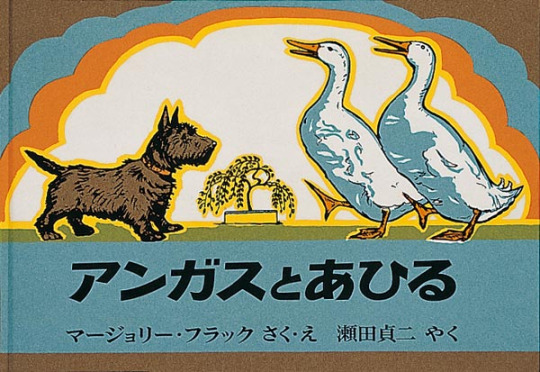
Angus, a curious Scottish terrier, decides to investigate the strange noise coming from the other side of the hedge, and there are a couple of ducks quacking.
Shelf: 726.6 FLA (@ tadoku section)
Angasu to ahiru.
by Mājorī Furakku ; translated by Seta Teiji.
Tōkyō : Fukuinkan Shoten, 1974.
ISBN: 4834004228
[32] unnumbered pages : colour illustrations ; 18 x 26 cm.
(Sekai kessaku ehon shirīzu. Amerika no ehon).
Translated into Japanese from the English. Hiragana and katakana only.

This book is suitable for tadoku, extensive reading for learners of Japanese-language. Please find details about tadoku and our reading night event on our tadoku web page.
2 notes
·
View notes
Text
Osaru ni naru hi
New item:

The little monkey boy is soon to be an elder brother. His mother monkey, of course, will bear a baby monkey, not other animals. The little monkey thinks it would be interesting if his younger sibling were a frog sister or a sea turtle brother… The story book depicts the budding responsibility of the monkey to become an elder brother.
Shelf: 913.6 ITO 4 (@ tadoku section)
Osaru ni naru hi.
by Itō Hiroshi.
Tōkyō : Kōdansha, 1994.
ISBN: 9784061978362
85 pages : illustrations (some colour) ; 22 cm.
(Dōwa ga ippai).
Text in Japanese, hiragana only.

This book is suitable for tadoku, extensive reading for learners of Japanese-language. Please find details about tadoku and our reading night event on our tadoku web page.
#children's stories#juvenile fiction#monkeys#japanese language#readers#tadoku level 2#jlearner#jteacher
0 notes
Text
Bamu to Kero no samui asa
New item:

It was a cold Tuesday morning when the nose was almost frozen, the pond must have been frozen as well on a day like this. Bam and Kero found Kai, the duck who was trapped in the frozen pond.
Shelf: 726.6 SHI B3 (@ tadoku section)
Bamu to Kero no samui asa.
by Shimada Yuka.
Tōkyō : Bunkeidō, 1996.
9784894231580 [32] unnumbered pages : colour illustrations ; 22 x 28 cm.
Regular print edition. Large print edition is also available from the library's collection.
Text in Japanese, hiragana katakana only.

This book is suitable for tadoku, extensive reading for learners of Japanese-language. Please find details about tadoku and our reading night event on ourtadoku web page.
#japanese language#readers#tadoku level 2#picture books for children#juvenile fiction#winter#dogs#frogs#jlearner#jteacher
0 notes
Text
Pan dorobō vs Nise pan dorobō
New item:

Bread Thief is a big thief who searches for delicious bread from all over the world. The baker's boss persuades him to become a baker, and he becomes a great baker too. However, the world's most delicious bakery in the forest is about to have another incident. ……?
Shelf: 726.6 SHI 2 (@ tadoku section)
Pan dorobō vs Nise pan dorobō.
by Shibata Keiko.
Tōkyō : Kadokawa, 2021.
ISBN: 9784041110355
[32] unnumbered pages : colour illustrations ; 25 cm.
(Pan dorobō no ehon ; 2).
Text in Japanese, hiragana and katakana only.

This book is suitable for tadoku, extensive reading for learners of Japanese-language. Please find details about tadoku and our reading night event on ourtadoku web page.
#japanese language#readers#tadoku level 2#juvenile fiction#picture books for children#bread#thieves#jlearner#jteacher
0 notes
Text
Uchi ni kaetta Garago
New item:

"Galago has come home from his journey when cold wind blows. Then his customers starts visiting him at his house, one after another......
Shelf: 726.6 SHI 2 (@ children’s book section)
Uchi ni kaetta Garago.
by Shimada Yuka.
Tōkyō : Bunkeidō, 2002.
ISBN: 9784894233317
[40] unnumbered pages : colour illustrations ; 21 x 30 cm.
Text in Japanese, hiragana katakana only.

This book is suitable for tadoku, extensive reading for learners of Japanese-language. Please find details about tadoku and our reading night event on our tadoku web page.
#juvenile fiction#bags#picture books for children#japanese language#tadoku level 2#jteacher#jlearner
0 notes